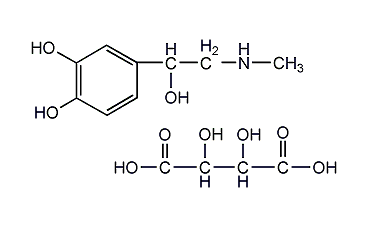
structural formula
| physical competition number | 014t |
|---|---|
| molecular formula | c13h19no9 |
| molecular weight | 333.29 |
| label |
l-3,4-dihydroxy-alpha-((methylamino)methyl)benzyl alcohol d-bitartrate, c9h13no3·c4h6o6 |
numbering system
cas number:51-42-3
mdl number:mfcd00035077
einecs number:200-097-1
rtecs number:do3500000
brn number:none
pubchem number:24277774
physical property data
1. characteristics: white crystalline powder. no odor and bitter taste.
2. density (g/ml,25/4℃): undetermined
3. relative vapor density (g/ml,air=1): undetermined
4. melting point (ºc):147 -152
5. boiling point (ºc,normal pressure): undetermined
6. boiling point (ºc,5.2kpa): undetermined
7. refractive index: undetermined
8. flashpoint (ºc): undetermined
9. specific optical rotation (ºc=1, in water):-17
10. autoignition point or ignition temperature (ºc): undetermined
11. vapor pressure (kpa,25ºc): undetermined
12. saturated vapor pressure (kpa,60ºc): undetermined
13. heat of combustion (kj/mol): undetermined
14. critical temperature (ºc): undetermined
15. critical pressure (kpa): undetermined
16. oil and water (octanol/log value of the partition coefficient of water:
17. explosion limit (%,v/v): undetermined
18. lower explosion limit (%,v/v): undetermined
19. solubility: soluble in water and ethanol, almost insoluble in chloroform and ether.
toxicological data
1, acute toxicity: rat subcutaneous ld50: 8300 ug/kg; rat intravenous ld50 : 82 ug/kg; mouse oral ld50: 4mg/kg; mouse abdominal cavity ld50: 7800ug/kg;
mouse subcutaneousld50: 11100 ug/kg; mouse vein ld50: 1780ug/kg; frog parenteral ldlo: 800mg/kg
2 , and many others metric toxicity: rat subcutaneous tdlo: 76mg/kg/42d-i
3 、 reproductive toxicity: male small mouse subcutaneous tdlo: 2400ug/kg, mated two days ago
4, mutagenicity: inhibitiontest system of dna: rodent –mouse cells –not otherwise specified: 1umol/l
ecological data
none
molecular structure data
none
compute chemical data
1. reference value for hydrophobic parameter calculation (xlogp):
2. number of hydrogen bond donors: 8
3. number of hydrogen bond acceptors: 10
4. number of rotatable chemical bonds: 6
5. number of tautomers: 10
6. topological molecular polar surface area (tpsa):188
7. number of heavy atoms: 23
8. surface charge: 0
9. complexity: 288
10. number of isotope atoms: 0
11. determine the number of atomic stereocenters: 3
12. the number of uncertain atomic stereocenters: 0
13. determine the number of stereocenters of chemical bonds: 0
14. uncertain number of chemical bond stereocenters: 0
15, number of covalent bond units: 2
properties and stability
none
storage method
seal and store in a dark place.
synthesis method
none
purpose
biochemical research.
extended-reading:https://www.bdmaee.net/catalyst-8154-nt-cat8154-polyurethane-catalyst-8154/extended-reading:https://www.bdmaee.net/adhesion-improvement-additive-nt-add-as3228/extended-reading:https://www.newtopchem.com/archives/44475extended-reading:https://www.bdmaee.net/catalyst-8154/extended-reading:https://www.newtopchem.com/archives/1830extended-reading:https://www.morpholine.org/nn-dicyclohexylmethylamine/extended-reading:https://www.cyclohexylamine.net/addocat-106-teda-l33b-dabco-polycat/extended-reading:https://www.newtopchem.com/archives/938extended-reading:https://www.bdmaee.net/wp-content/uploads/2021/05/137-4.jpgextended-reading:https://www.newtopchem.com/archives/661

